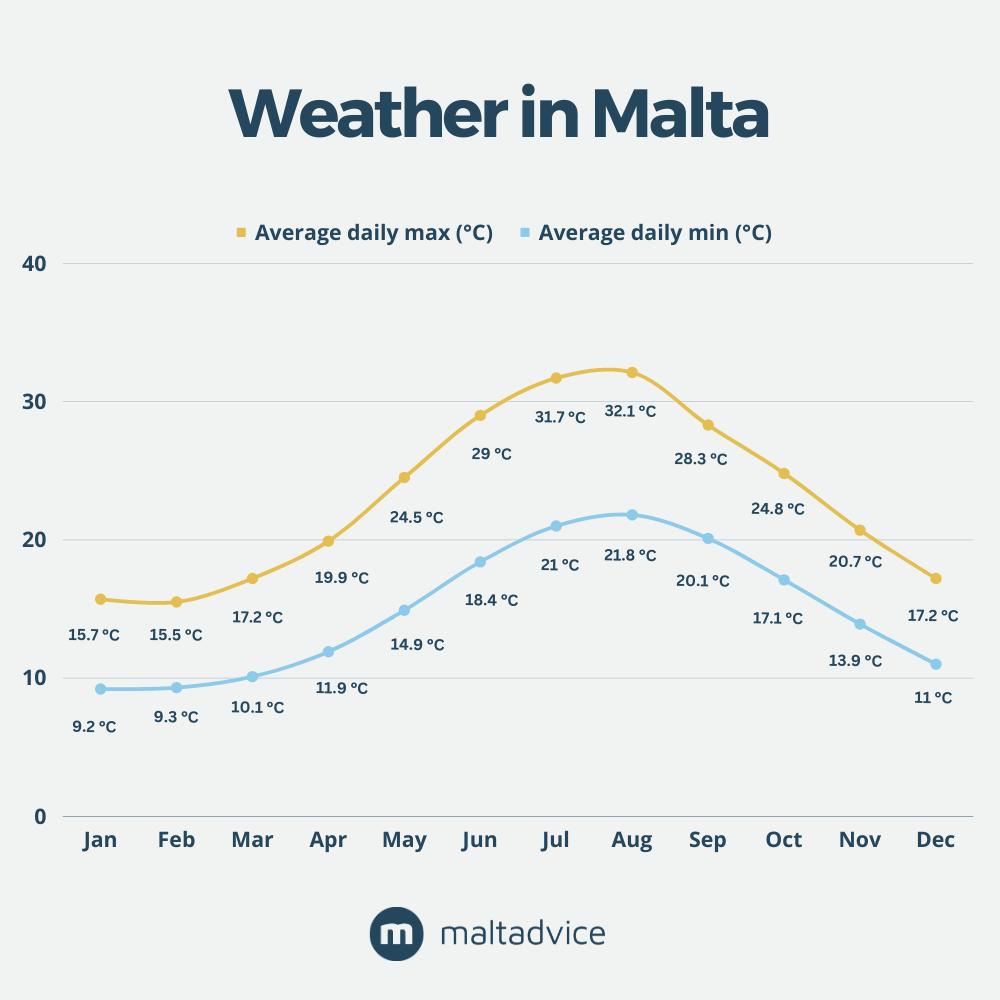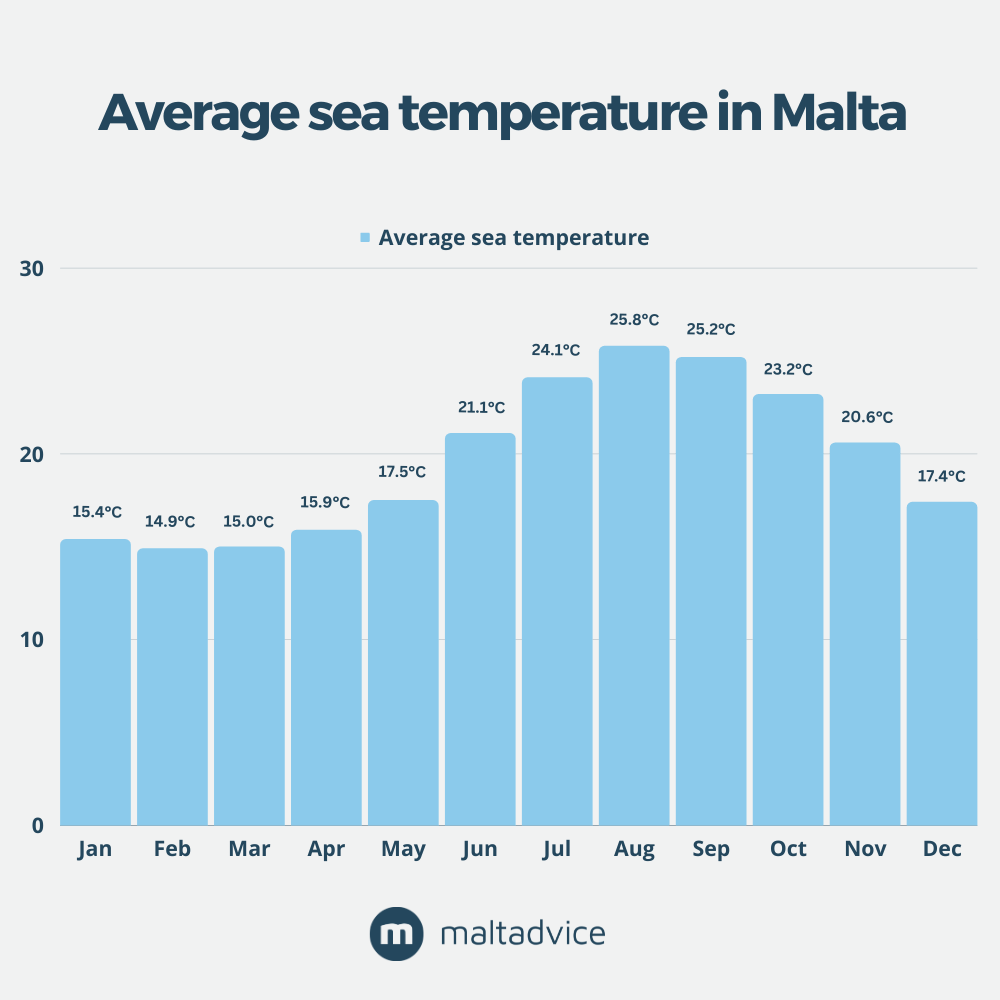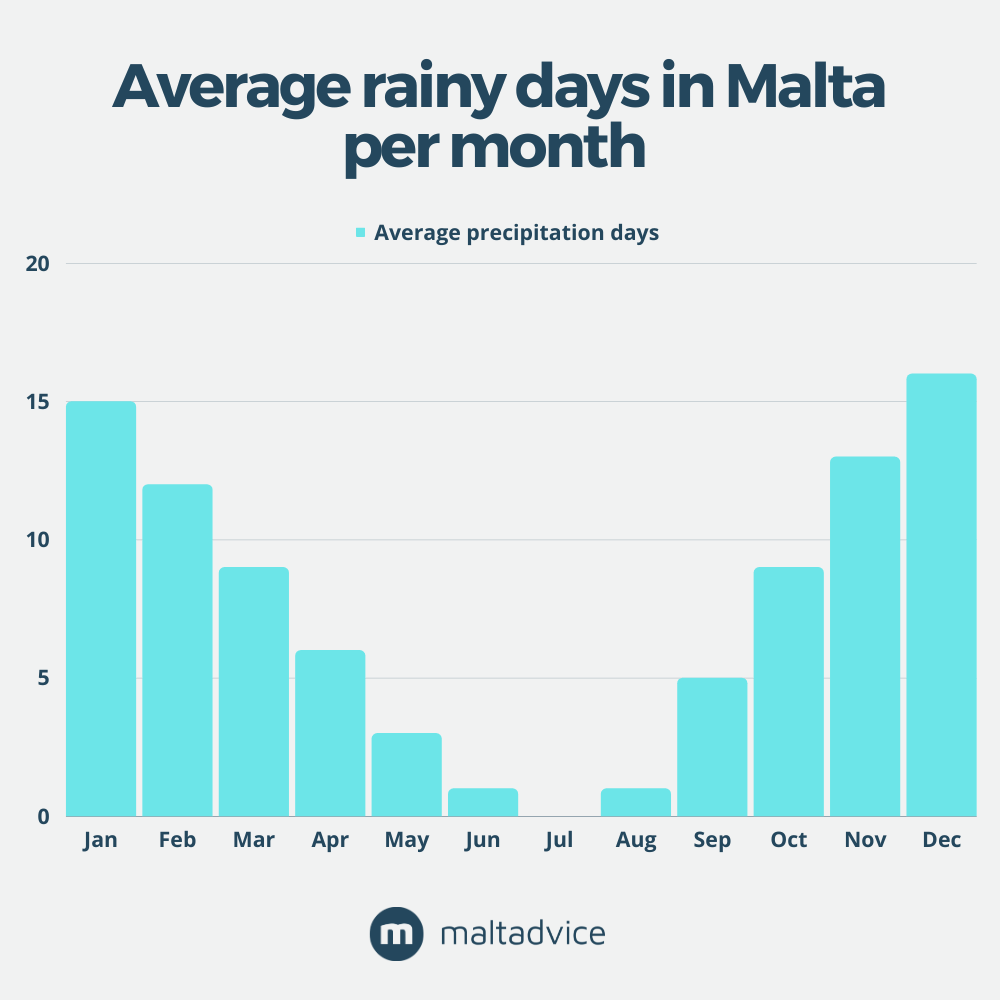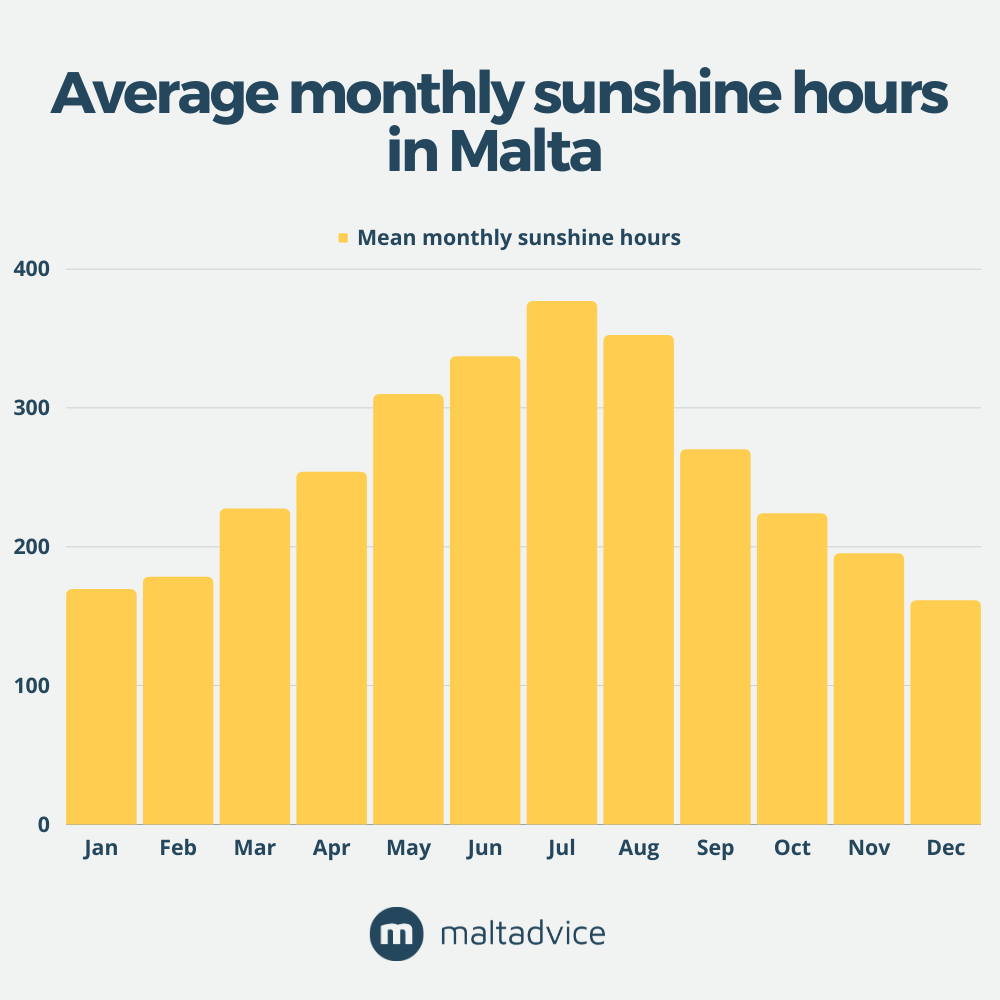What is Malta’s climate like?
Malta enjoys a Mediterranean climate, strongly marked by a climatic phenomenon: the arrival of the Sirocco.
The Sirocco is a wind originating from the Sahara that arrives in Malta at the end of spring and establishes itself during the summer. This wind is extremely dry and hot, transforming the island’s climate within days.
Summers in Malta are very hot and dry, while winters are mild and humid. Although rainfall is infrequent, it can be intense during the winter, turning the island into a true spectacle of waterfalls. Additionally, Malta is prone to storms and marine winds due to its location in an archipelago.
Another peculiarity of the island is the presence of ambient humidity that extends from sunset in October to April, due to its proximity to the coast.
Temperatures in Malta
In Malta, the average annual temperature is around 20 degrees Celsius. During winter, temperatures rarely drop below 10 degrees Celsius. From early June, with the arrival of the Sirocco wind, temperatures begin to rise and can exceed 30 degrees Celsius.
The water temperature in Malta is pleasant from May until late October, allowing for water activities for most of the year. However, there are brave individuals who swim even during the colder months. It is common to see Maltese people taking a dip in Spinola Bay in mid-December.


Malta’s climate in seasons
The best time to visit Malta depends on your personal preferences and the activities you wish to engage in during your trip. In general, the high season in Malta extends from mid-June to September, when the weather is warm and the beaches are at their peak.


Summer in Malta
Summer (June-August): If you love the beach atmosphere, summer activities, outdoor concerts, and festivals, then the summer months are ideal for you. During this period, the temperatures are warm, and the beaches are at their finest. However, keep in mind that there may be more tourists, and prices can be higher.
Spring and autumn in Malta
Spring (April-May) and Autumn (September-October): These seasons are excellent for those who prefer to avoid crowds and enjoy milder weather. During spring and autumn, the temperatures are pleasant and perfect for outdoor activities, such as cultural visits, exploring the historical sites of Malta, the fortified cities, and museums.
Winter in Malta
The weather in Malta in winter (November-March) is relatively cool but still mild compared to other European destinations. If you are looking for tranquility and are not intimidated by strong rain and wind, visiting Malta during these months is a great opportunity to explore the island and its beauty. In winter you can visit all the sights and museums without the hassle.
The weather in Malta by month
January
Average temperature
13°
16°
12 days of rain
January is the coldest month in Malta with a lot of humidity in the air. It’s not the ideal month, but that doesn’t mean you can’t do tourist or cultural activities.
February
Average temperature
13°
15°
12 days of rain
February, like January, is also a rather cold month, but it is, on the other hand, the least touristy month and therefore the most affordable month to travel.
March
Average temperature
14°
15°
9 days of rain
March marks the beginning of the thaw in the archipelago. Precipitation is decreasing, making the island suitable for outdoor visits, but not yet suitable for beach activities.
April
Average temperature
16°
16°
6 days of rain
April allows you to discover the island, it is a mild month and perfect for hiking and trekking activities. The water is still cool, which limits swimming activities.
May
Average temperature
20°
18°
3 days of rain
May is one of the best months to come to Malta. The weather is ideal for discovering the island and for the brave it is possible to swim.
June
Average temperature
23°
22°
1 days of rain
The best month to come to Malta. Temperatures are warm but not sweltering and it is ideal for swimming. June will please the vast majority of travellers.
July
Average temperature
27°
25°
0 days of rain
July is one of the two hottest months. A perfect month to go to the beach, but this should be avoided by all those who are sensitive to heat.
August
Average temperature
27°
27°
1 day of rain
August is the hottest month to come to Malta. The temperature rarely drops below 25° at night. If you like the heat, it’s ideal, if you’re sensitive to it, this is the month to avoid.
September
Average temperature
25°
26°
5 days of rain
September often marks the end of the Sirocco, the heat is still present, but the air is less dry and the sea remains warm. One of the three best months for a stay in Malta.
October
Average temperature
21°
24°
9 days of rain
October, an ideal month for holidays in Malta. The water is warm, the temperature is high. You can visit everything without suffering from the heat and prices in Malta go down.
November
Average temperature
17°
22°
13 days of rain
November marks the real end of the summer period, the arrival of the rains and the drop in temperatures. The sea is still warm, so swimming is still possible.
December
Average temperature
14°
19°
13 days of rain
December, the rainiest month in Malta. Temperatures remain mild, but the island sometimes turns into a real torrent that can hamper many activities.
Weather in Malta in January
January in Malta is the coldest month in the archipelago, it is also a very windy month. The air temperature does not usually drop below 10 degrees, the thermometer usually ranges between 12 and 16 degrees, but the feeling is usually below this due to the humidity.
The temperature of the sea water is around 15 degrees. January is one of the quieter months on the island, most tourist activities and excursions are still available, but it’s important to wrap up warm and avoid rainy days.
Weather in Malta in February
In February, the weather in Malta is similar to January, with a difference of one or two degrees on average. The air temperature is slightly milder than in January, although it still remains cool. On the other hand, the temperature of the sea water tends to decrease by a few degrees.
February is considered the ideal month for those looking for a budget-friendly trip to Malta. The prices of hotels and accommodations on the island are typically at their lowest during this month, providing an opportunity to find very good deals.
Weather in Malta in March
In March, the islands of Malta begin to regain their color and vitality, and the thermometer starts to rise again. Temperatures range from 15 to 20 degrees Celsius, with some days even reaching up to 22 degrees Celsius. Although the weather is pleasant, it is still a bit early for water activities as the sea water remains cold at around 16 degrees Celsius.
While the cooler March weather might deter some from beach activities, it is an exceptional time for trekking and exploring Malta’s rich cultural offerings like to explore Gozo, Malta’s charming sister island. March offers the perfect climate for trekking and taking in the serene beauty without the peak season crowds.
Weather in Malta in April
In April, spring in Malta is in full bloom, and the beauty of nature is evident with flowers and fragrances everywhere, even near the main cities. The air begins to warm up, and temperatures range between 18 and 22 degrees. However, the seawater is still cool. April is a very suitable month to explore the island, as the weather is not too hot, allowing for comfortable outdoor activities.
Weather in Malta in May
The month of May marks the beginning of the best period to visit Malta and is considered one of the most pleasant months. May is a perfect time to enjoy the beauty of Malta and engage in a variety of outdoor activities. You can explore picturesque beaches and coves, indulge in water sports, dive into crystal-clear waters, or simply relax under the sun. It is also the ideal time in Malta for excursions, visiting historical sites, and immersing yourself in the rich Maltese culture.
Weather in Malta in June
The month of June in Malta is very pleasant, with warm temperatures yet less crowded than the months of July and August. If you want to enjoy the sun while seeking some peace and tranquility, June is the ideal time to travel to Malta. You can relish beautiful and less crowded beaches, explore tourist attractions and cultural sites without the typical high season crowds.
Weather in Malta in July
July is the hottest month in Malta. During the day, it’s advisable to spend time near the sea as the heat is usually dry. If you rent an apartment or other accommodation, make sure it has air conditioning to keep you cool. Remember to use sunscreen with SPF 50+ and stay well-hydrated.
The sea water temperature warms up to reach 26 degrees, making it pleasant for swimming. During July, rainfall is exceptionally scarce in Malta. However, due to the intense heat, carrying out daily activities and visiting tourist spots can be quite challenging without proper planning and precautions.
Weather in Malta in August
The month of August is the most sought-after time by travelers to visit Malta. During this month, the Mediterranean island is filled with tourists, as it offers a hot and sunny climate, perfect for enjoying the beaches in Malta.
In August, temperatures in Malta are high, with values exceeding 30 degrees during the day. The sea in Malta reaches its highest temperature during this month, with waters staying above 26 degrees. This makes it ideal for swimming, water sports, and relaxing on the island’s beaches.
Weather in Malta in September
The weather in Malta in September is truly delightful. This month is considered one of the best times to visit the archipelago, along with May, June, and October. The temperatures are neither too cold nor too hot, making it a very pleasant period to explore the island.
The water temperature in September is quite high, allowing you to enjoy activities and swim in the sea without any issues. Moreover, during this month, the influx of tourists starts to decrease as the school holidays in Europe come to an end, which means you can experience Malta in a more peaceful and relaxed manner.
Weather in Malta in October
October in Malta is a sunny and warm month. Contrary to popular belief, there is no monsoon season on the island. However, some periods of rain may occur towards the end of October. Despite this, tourists continue to bask in the October sunshine on the beaches.
The temperatures in October are pleasant, without being stifling. The weather offers a very comfortable air temperature for outdoor activities. It’s a perfect month for enjoying walks through picturesque landscapes and exploring the charming corners of the island.
Weather in Malta in November
The weather in Malta in November is quite changeable. During the first half of the month, it is characterized by sunny and pleasant days, while many parts of Europe are already preparing for winter. In Malta, you can still enjoy a warm climate.
However, starting from the second half of November, the rainy season begins in Malta and the weather can change rapidly. You may experience sunny mornings followed by heavy rain and storms in the afternoon.
Weather in Malta in December
The weather in Malta in December is beautiful in its own way. December is a cool month. The temperature does not drop below 11 degrees, but the nights are cool and damp. The island can turn into a New Year’s fairytale with temperatures of around 18 degrees during the day. The island can also become a natural waterfall. Sea storms, heavy December rains and the lack of an efficient rainwater harvesting infrastructure sometimes make the island chaotic.
Frequently Asked Questions About Weather in Malta (FAQ)
What are the best months to go to Malta?
Malta enjoys a temperate Mediterranean climate with high summer temperatures. It is possible to enjoy Malta in any season, but in general May, June, September and October are the most pleasant months to make the most of all the activities and must-see sights in Malta. Find out the daily forecast, air quality and other details on the website TWC.
How many days of rainfall does Malta experience throughout the year?
On average, around 60 to 80 days of rain are expected per year in Malta. However, it is important to note that the distribution of rainfall can vary throughout the seasons. Winter months tend to be wetter, with a higher likelihood of precipitation, while summer months are usually drier.
What is the hottest month in Malta?
The hottest month in Malta is usually July. August is also affected by very high temperatures, but is more prone to sea storms.
What is the coldest month in Malta?
The coldest month in Malta is usually January, but sometimes it is also February. The month with the lowest temperatures does not usually have a thermometer below 10 degrees Celsius.
Does it snow in Malta?
It is exceptional to see snow in Malta, but not impossible. The last case of snowfall in Malta was recorded on 31 January 1962, when a 3 centimetre layer of snow covered the island of the Knights of the Order.
What is the water temperature like in Malta?
The water temperature in Malta varies throughout the year. In the colder months, such as January and February, the water temperature is usually around 16 degrees Celsius. As spring and summer progress, the waters gradually warm up. In May, the water temperature reaches around 19 degrees Celsius and continues to increase throughout the summer. During the warmer months, like July and August, the water temperature can exceed 25 degrees Celsius. In the autumn, the water temperature starts to gradually decrease again.

Malta is known for its pleasant Mediterranean climate, with plenty of sunshine and mild temperatures, making it very appealing to travelers. Snowfall is extremely rare on the island, and the last occurrence was on January 31, 1962, when a few centimeters of snow were recorded, lasting only for a few hours. Find out the weather in Malta and get general information about the climate in this wonderful Maltese archipelago.